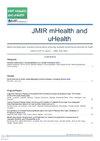User Experience of Persons Using Ingestible Sensor–Enabled Pre-Exposure Prophylaxis to Prevent HIV Infection: Cross-Sectional Survey Study
IF 6.2
2区 医学
Q1 HEALTH CARE SCIENCES & SERVICES
引用次数: 0
Abstract
Background: The success or failure of a digital health technology depends upon how it is received by the user. Objective: We conducted a detailed evaluation of user experience (UX) amongst persons who utilized an FDA-approved digital health feedback system (DHFS) incorporating ingestible sensors (IS) to capture medication adherence, after they were prescribed oral pre-exposure prophylaxis (PrEP) to prevent HIV infection. We then performed an association analysis with individual participant characteristics captured at baseline, to see if ‘personas’ associated with positive or negative UX emerged. Methods: UX data was collected upon exit from a prospective intervention study of HIV-negative adults prescribed oral PrEP who used the DHFS with ingestible sensor-enabled tenofovir disoproxil fumarate plus emtricitabine (IS-Truvada®). Baseline demographics, urine toxicology, and self-report questionnaires evaluating sleep (PSQI), self-efficacy, habitual self-control, HIV risk perception (PRHS 8-item), and depressive symptoms (PHQ-8) were obtained. Participants with ≥ 28 days on study completed a Likert-scale UX questionnaire of 27 questions grouped into 4 domain categories: Overall Experience, Ease of Use, Intention of Future Use, and Perceived Utility. Averages and interquartile range (IQR) were computed for participant total and domain sub-scores, and mixed-effects logistic regression modeled baseline participant characteristics associated with UX responses. Demographic characteristics of participants who responded to the questionnaire versus non-responders were compared using Fisher’s exact test. Results: Seventy-one participants enrolled with a mean age of 37.6 years (range 18-69), 90.1% male, 77.5% white, 33.8% Hispanic, 95.8% housed and 74.6% employed. No difference in demographics were observed in the 63 participants who persisted on the intervention for ≥28 days. Participants completing the detailed exit UX questionnaire (n= 53) were housed (98.1% vs 80%; p=0.063) and less likely to have a positive urine toxicology (35.3% vs 70%; p=0.075), particularly with methamphetamine (7.8% vs 40%; p=0.020), than non-completers (n=10). Based on IQR values 75% of participants had favorable UX with Total Score (IQR 3.17-4.20), mean(SD) 3.74 (0.70); Overall Experience (IQR 3.50-4.50), mean (SD) 3.89 (0.87); Ease of Use (IQR 3.33-4.22), mean (SD)=3.74 (0.65); and Perceived Utility (IQR 3.22-4.25), mean (SD)=3.73 (0.76). At least 50% of participants expressed Intention of Future Use (median=3.80, IQR 2.80-4.40). Following multi-predictor modeling self-efficacy was significantly associated with the total score 0.822 (0.405. 1.240) p<0.001, and all sub-scores. Persons with more depressive symptoms reported better perceived utility, worse PHQ-8 score natural cubic spline with 3 knots, overall p=0.013. Poor sleep was associated with a worse overall experience, per point PSQI -0.07 (-0.133, -0.006) P<0.032. Conclusions: User Experience amongst persons using ingestible sensor-enabled PrEP (IS-Truvada®) to prevent HIV infection was positive. Association analysis of participant characteristics at baseline, identified higher self-efficacy was associated with positive UX experience, more depressive symptoms with higher perceived utility, and poor sleep with negative UX experience. Clinical Trial: ClinicalTrials.gov NCT03693040; https://clinicaltrials.gov/study/NCT03693040使用可摄入传感器的暴露前预防法预防艾滋病毒感染的用户体验:横断面调查研究
背景:数字医疗技术的成败取决于用户对它的接受程度。我们的目标是我们对用户体验(UX)进行了一项详细评估,评估对象是那些使用了美国食品及药物管理局(FDA)批准的数字健康反馈系统(DHFS)(该系统结合了可摄取传感器(IS))来捕捉用药依从性的人,在他们被处方口服暴露前预防药物(PrEP)以预防艾滋病毒感染之后。然后,我们对基线捕捉到的参与者个人特征进行了关联分析,以了解是否出现了与积极或消极用户体验相关的 "角色"。研究方法用户体验数据是在一项前瞻性干预研究结束后收集的,该研究的对象是HIV阴性成人口服PrEP处方者,他们使用了带有可摄入传感器的富马酸替诺福韦二吡呋酯加恩曲他滨(IS-Truvada®)DHFS。研究人员采集了基线人口统计学数据、尿液毒理学数据以及评估睡眠(PSQI)、自我效能、习惯性自我控制、HIV 风险认知(PRHS 8 项)和抑郁症状(PHQ-8)的自我报告问卷。参与研究时间≥ 28 天的参与者填写了一份李克特量表用户体验问卷,其中包含 27 个问题,分为 4 个领域类别:总体体验、易用性、未来使用意向和感知效用。计算了参与者总分和领域子分的平均值和四分位数间距(IQR),并对与用户体验回答相关的参与者基线特征进行了混合效应逻辑回归建模。使用费舍尔精确检验比较了回答问卷与未回答问卷的参与者的人口统计学特征。结果71名参与者的平均年龄为37.6岁(18-69岁不等),90.1%为男性,77.5%为白人,33.8%为西班牙裔,95.8%有住房,74.6%有工作。在 63 名坚持干预≥28 天的参与者中,没有观察到人口统计学方面的差异。与未完成干预者(人数=10)相比,完成详细退出用户体验问卷的参与者(人数=53)有住房(98.1% vs 80%;p=0.063),尿液毒理学呈阳性的可能性较小(35.3% vs 70%;p=0.075),尤其是甲基苯丙胺(7.8% vs 40%;p=0.020)。根据 IQR 值,75% 的参与者用户体验良好,总分(IQR 3.17-4.20),平均(标清)3.74(0.70);总体体验(IQR 3.50-4.50),平均(标清)3.89(0.87);易用性(IQR 3.33-4.22),平均(标清)=3.74(0.65);感知效用(IQR 3.22-4.25),平均(标清)=3.73(0.76)。至少 50%的参与者表达了未来使用意向(中位数=3.80,IQR 2.80-4.40)。根据多预测因子模型,自我效能感与总分 0.822 (0.405. 1.240) p<0.001 及所有分值均有显著相关性。抑郁症状较重者的实用感知较好,PHQ-8 得分较低,自然三次样条曲线有 3 个结,总分 p=0.013。睡眠不佳与总体体验较差有关,每点 PSQI -0.07 (-0.133, -0.006) P<0.032。结论使用可摄取传感器支持的 PrEP(IS-Truvada®)预防艾滋病毒感染的用户体验是积极的。对基线参与者特征的关联分析表明,较高的自我效能感与积极的用户体验相关,较多的抑郁症状与较高的感知效用相关,睡眠不佳与消极的用户体验相关。临床试验:ClinicalTrials.gov NCT03693040; https://clinicaltrials.gov/study/NCT03693040
本文章由计算机程序翻译,如有差异,请以英文原文为准。
求助全文
约1分钟内获得全文
求助全文
来源期刊

JMIR mHealth and uHealth
Medicine-Health Informatics
CiteScore
12.60
自引率
4.00%
发文量
159
审稿时长
10 weeks
期刊介绍:
JMIR mHealth and uHealth (JMU, ISSN 2291-5222) is a spin-off journal of JMIR, the leading eHealth journal (Impact Factor 2016: 5.175). JMIR mHealth and uHealth is indexed in PubMed, PubMed Central, and Science Citation Index Expanded (SCIE), and in June 2017 received a stunning inaugural Impact Factor of 4.636.
The journal focusses on health and biomedical applications in mobile and tablet computing, pervasive and ubiquitous computing, wearable computing and domotics.
JMIR mHealth and uHealth publishes since 2013 and was the first mhealth journal in Pubmed. It publishes even faster and has a broader scope with including papers which are more technical or more formative/developmental than what would be published in the Journal of Medical Internet Research.
 求助内容:
求助内容: 应助结果提醒方式:
应助结果提醒方式:


